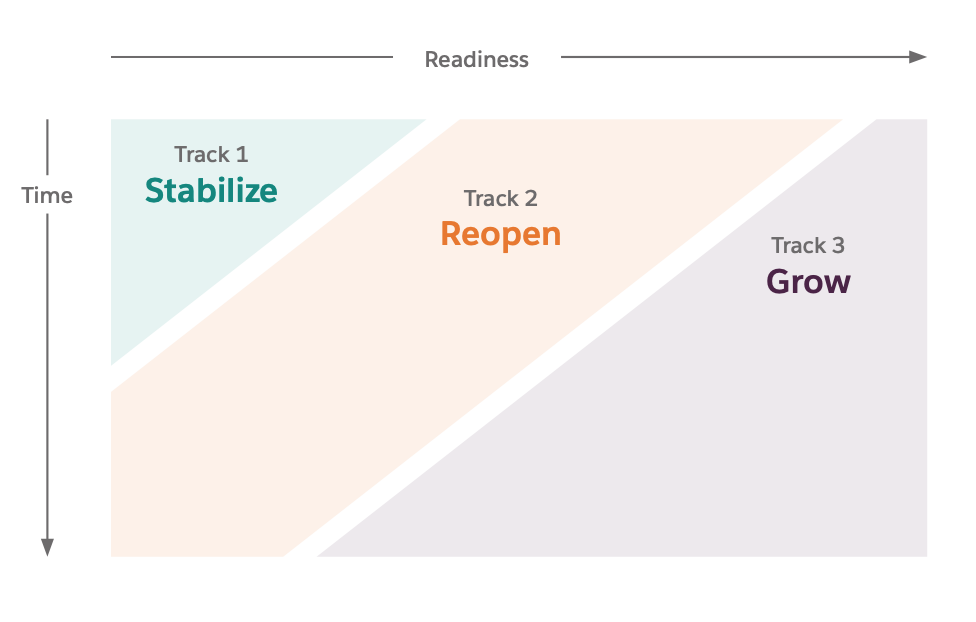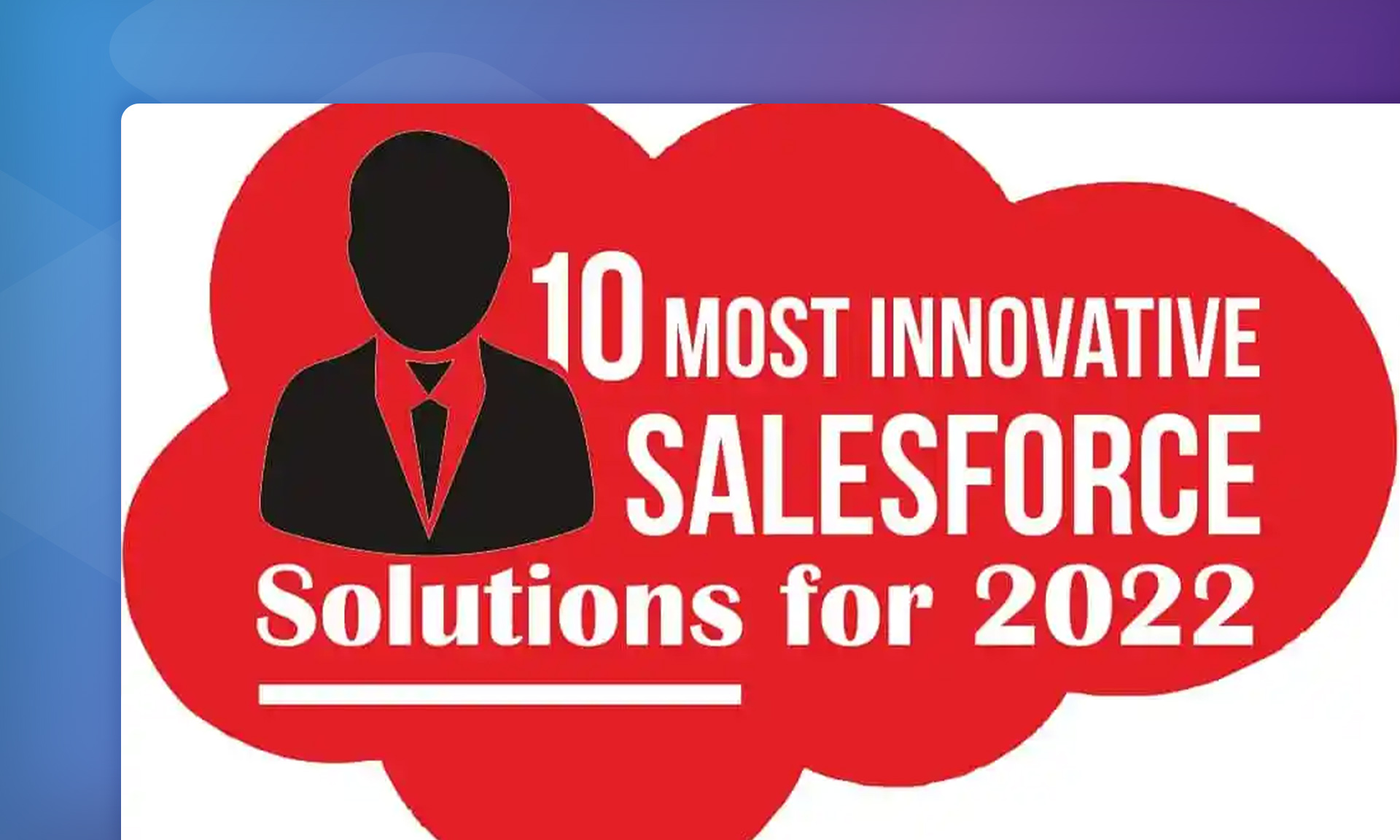
Elements is an official Work.com partner
THINKING AHEAD
Salesforce, as ever, is thinking ahead of the game. Whilst everyone was trying to come to terms with shutdown, Salesforce created an excellent COVID-19 Response playbook to help leaders and managers understand how to transition through the stabilize, reopen and into the growth phases.
In this recent SalesforceBen article I discussed the implications on organization of the rapid digital transformation that is required in the reopen and growth phases. It also explored the demands it will put on Admins to drive far faster and more rigorous implementation cycles. Going faster is not about missing out steps, but it is about reuse of documentation and automation to improve impact analysis. This enables speed and trust.
BACK TO WORK.com
But as Salesforce thought through the phases, for themselves and others, they identified a major hole. Getting people back to work safely would require some completely new operational processes and apps such as employee wellness checking, track and trace, and shift management. Executives need dashboards to monitor the financial health of the company. But now they would need a command center to monitor the physical health of their organization over the short to medium term. Reopen is a phase, not a date in time.
Which is why Work.com is so inspired. Salesforce has taken the proven set of platform features that we all know and love and have repurposed them as a set of apps designed to support the reopen phase. And all of this is anchored around the Work.com Command Center — a dashboard that can draw data from internal and external data feeds and Tableau. Finally, they dusted off work.com, the domain of a company they bought back in 2012.
Leaning heavily on configure rather than code, and rethinking how core capabilities can be used (FSL is shift management, Surveys is employee wellness) has enabled Salesforce to deliver Work.com in a remarkable timeframe with limited technical risk. The platform approach means that any customer, SI or ISV can extend Work.com or write new apps. The Work.com Command Center has been designed so customers and ISVs can drop their feeds into it easily. The only big change is that there are several new standard objects that appear in any new Org. These went straight into GA, so there must have been some anxious moments in the early hours of 1 June. But kudos to the team. They delivered.
1st IMPRESSIONS
A recent SaleforceBen article talked about the scope of Work.com based on marketing and demos, but on 1 June partners and customers could stand up an Org and start kicking the tires. We were like big kids waiting for Christmas. By the end of the day we had a Work.com Org installed and configured. We had installed the Wellness Survey, Shift Management and myTrailhead managed packages. We also installed a couple of ISV packages — Reputation Studio and Traction Guest — that had been developed alongside Work.com.
Much of this was very familiar, particularly if you live in Lightning. The installation instructions were well written and easy to follow. So much so that we did it twice!! Our CTO, in his excitement, mistyped our domain name as elements-LOUD in the MyDomain. As avid readers of OrgConfessions.com will know, it cannot be changed. So rather live with the shame, he decided to create a whole new implementation — elementswork.
It probably took a couple of hours to get the core platform all set up and running. Then it will need to be configured, just like any Org, to meet the business needs. There are still Work.com and ISV apps that have not yet been delivered and there will be more apps being launched as new opportunities are identified. Salesforce has launched a new site join.work.com to encourage partners to develop apps and they seem to be prioritizing security reviews for Work.com apps. Our experience is that if you build your app and religiously adhere to the best practice standards it makes this far faster.
IMPLEMENTATION APPROACH
Organizations are already starting to reopen, so speed is critical. And as Work.com is focused on employees rather than customers the recommendation is that this is a brand new Org. But it will need to be configured to meet the specific needs of every organization. Don’t expect to use it straight out of the box. For a start, organizations already have a database of employees that will need to be kept in sync with Work.com. You may have seen last week’s announcement of an integration with WorkDay. Whilst it is an obvious collaboration, no details have surfaced yet. Decisions will need to be made on data privacy policies. What is the strategy on wellness checks? More on this later.
Work.com is not free. You will need a Platform licenses plus licenses for the Work.com apps and any ISV apps. Here is a link to the Salesforce Work.com pricing page and this is clearly an exciting new revenue opportunity for Salesforce enabling them to get into the HR space.
RISK, RISK, RISK
So I look at any implementation from the perspective of risks in 3 areas:
- Organizational: what impact does this have on the business?
- Technical: how hard is this to deliver?
- Regulatory: what compliance risks are there?
Here is Work.com’s scorecard:
HIGH RISK
These are new operational processes supported by a completely new system that employees are going to have to learn and adopt. These are in addition to running the business. They will also need to be highly agile because no-one has a “reopen playbook”. Business processes and the apps will need to evolve quickly to adapt to the changing business environment. 5 years of digital transformation is being compressed into 5 months. This will put a significant strain on organizations.
LOW RISK
This is a new Org with limited external integrations based on a proven stable platform. For some organizations locked in Classic, this is a chance to benefit from Lightning and an opportunity to learn from past experiences. Many (everyone) wants to build in a way that minimizes the technical debt that hobbled them in previous implementations; configure not code; proper documentation; formal CI/CD cycle. LOW RISK becomes MEDIUM RISK if organizations try to take shortcuts to implement faster. It will catch up with them.
Regulatory: HIGH RISK
The data privacy implications are significant. Wellness surveys are asking employees about their medical status. Track and trace require consents far beyond those expected by any employee. What consents are visitors expected to sign and should they be covered by track and trace? GDPR and CCPA have largely been ignored in the effort to control the pandemic, but this cannot be the status quo. Finally, some of the operational processes such as track and trace will require evidence that those performing the work are following documented processes. Food, pharma, financial services and construction are used to this oversight. This may be a rude awakening for other industries.
RISK MITIGATION
We set ourselves a challenge. We got the Work.com Org on 1st June. In a single day, could we develop the operational business processes diagrams for the areas that the Work.com and ISV apps supported. And could we sync the Org into a metadata dictionary with items linked to the key process steps. Finally, could we extend the Salesforce help icons for key objects and fields with pop-up help linked to process diagrams, video and notes.
BTW This took one of the team, all day on 1 June, but he delivered it. Now any customers or partners can log in and see what we have done, and then copy and reuse it for themselves. We just need to invite them to our Work.com Space. Elementswork.com We know that this process-driven approach is critical to reducing risk in the two high risk areas — organizational and regulatory. But it also supports a more rigorous implementation approach which reduces technical risk.
We have built a Work.com Org and a site which has process diagrams, Org metadata dictionary and links to in-app help. Ping us on success@elements.cloud to get access.
Here is a short overview video of Work.com and a typical use and how the content we have created can increase adoption.
NO TIME TO LOSE
Businesses are already looking at how they reopen and much of the operational thinking is being done. If Work.com is going to make an impact it needs to be delivered in days, not weeks or months. There will be some configuration and there are SI Partners who are ramping up their Work.com skills to be able to support customers.
I believe it all starts with agreeing the new operational processes so the configuration requirements are crystal clear. The process content we have developed can be freely used by anyone as a starting point — super-accelerators. But, by far the largest challenge is adoption; getting employees up to speed on a novel set of applications with the confidence that they are entering clean data and staying compliant. That is why the tailored process diagrams must be delivered inside Salesforce record pages alongside other content (notes, videos, wiki pages) as “point of need” training with an easy mechanism to gather end user feedback that can be fed into the next cycle of changes. Training content should iterate hourly. Apps should iterate daily. That is the NewNormal.
A NIMBLE BEAST
For many organizations, getting back to work will be a defining moment. Those that can execute at pace in the new digital world will dominate.
Walmart, despite its size, has proven to be nimble. Before COVID-19 it offered “ship from store” from 100 locations. Then when its 45 online fulfilment centers became quickly overwhelmed, it expanded the approach to 2,500 stores. It piloted 2 hour delivery at 100 stores and a few weeks later has expanded it to over 1,000. The results; 9.5% increase in sales which is 3x its normal growth rate, and online shopping is up 400% compared with a year ago.
Sign up for
our newsletter
Subscribe to our newsletter to stay up-to-date with cutting-edge industry insights and timely product updates.










